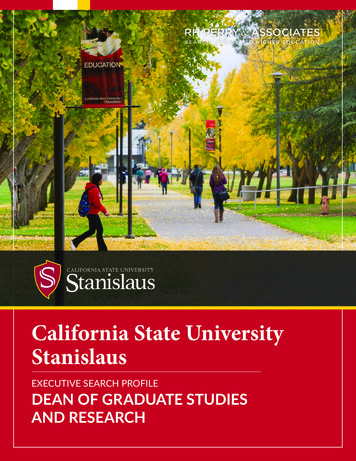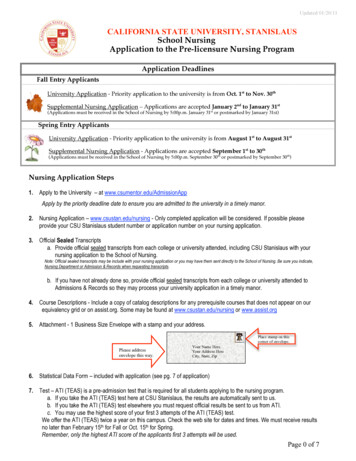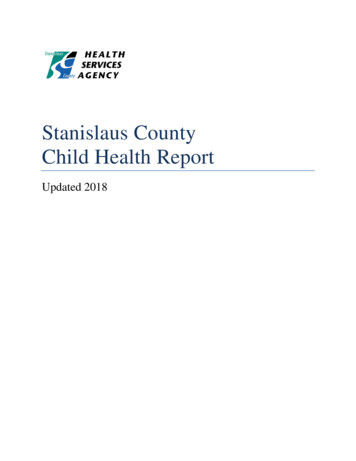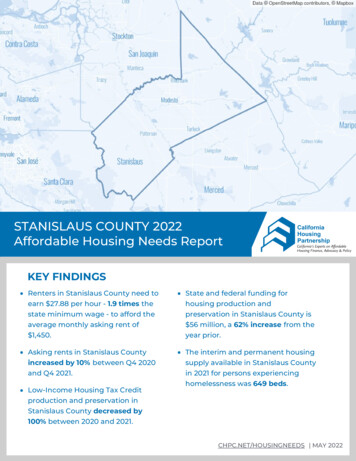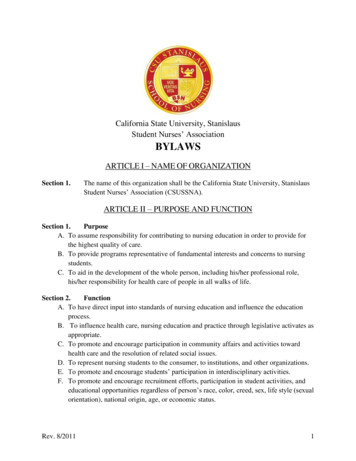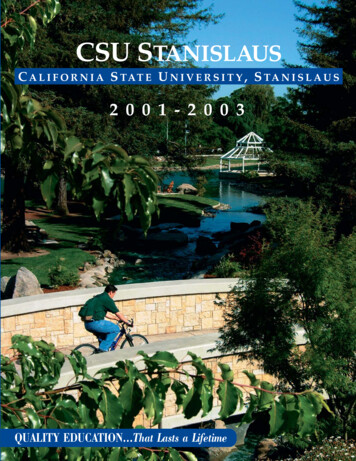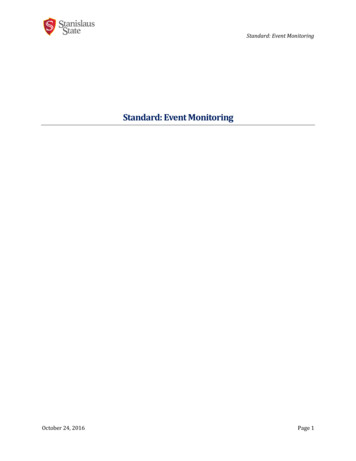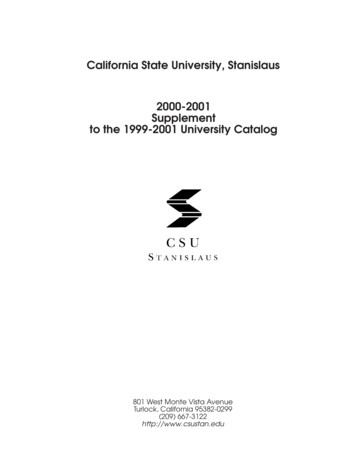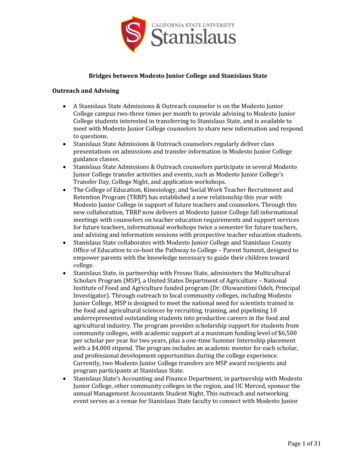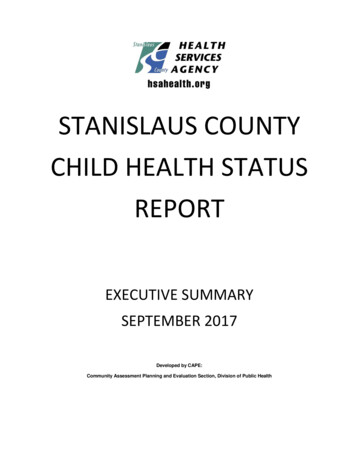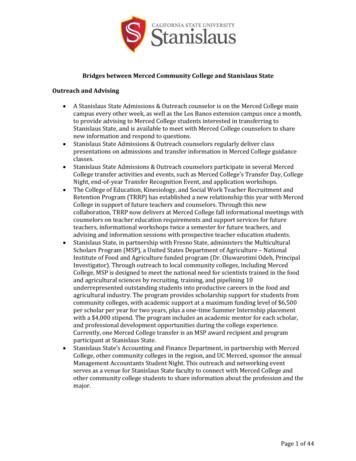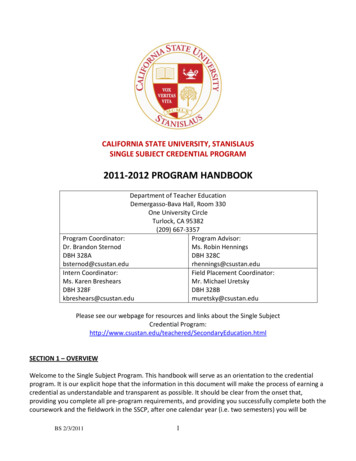
Transcription
CALIFORNIA STATE UNIVERSITY, STANISLAUSSINGLE SUBJECT CREDENTIAL PROGRAM2011-2012 PROGRAM HANDBOOKDepartment of Teacher EducationDemergasso-Bava Hall, Room 330One University CircleTurlock, CA 95382(209) 667-3357Program Coordinator:Program Advisor:Dr. Brandon SternodMs. Robin HenningsDBH 328ADBH n Coordinator:Field Placement Coordinator:Ms. Karen BreshearsMr. Michael UretskyDBH 328FDBH se see our webpage for resources and links about the Single SubjectCredential Education.htmlSECTION 1 – OVERVIEWWelcome to the Single Subject Program. This handbook will serve as an orientation to the credentialprogram. It is our explicit hope that the information in this document will make the process of earning acredential as understandable and transparent as possible. It should be clear from the onset that,providing you complete all pre-program requirements, and providing you successfully complete both thecoursework and the fieldwork in the SSCP, after one calendar year (i.e. two semesters) you will beBS 2/3/20111
eligible for a teaching credential. The type of credential you will earn is called a Preliminary Credentialwith a 2042 Authorization. This is a long way to say that your credential will reflect recent legislation inCalifornia as well as No Child Left Behind mandates. This credential replaces the CLAD certificate. In mostcases, this credential qualifies you to teach 6-12 grades in your content area. It is also possible to earn aBilingual Credential, which qualifies you to work in more intensive English Language Developmentclasses in your content area.Required CoursesThe coursework in the SSCP involves a number of classes, each designed for two related purposes: toaddress a specific dimension of the teaching profession and to meet state standards for credentialingprograms.The Core Courses (EDSC 4000 or 4100, 4300, 4350, 4400 and 4450) are designed to provide a consistentframework through which credential candidates can process the experiences of learning to teach. Thesecourses address foundational aspects of teaching, such as educational philosophy, learning psychology,and curriculum theory as well as more practical dimensions of teaching such as student assessment,classroom management, and instructional planning. These courses are taught by the field centerdirectors for student teachers and intern directors in the case of internship program. The directors andcoordinators are not only the main instructional presence in the program, but also serve as advisors,liaisons with schools and mentor teachers, and support credential candidates in many ways.Fieldwork courses (EDSC 4850 and 4855 or EDSC 4870 and 4875) are really not courses, but ratherexperiences in the schools. 4850 is the first semester of fieldwork for student teachers and typicallyincludes classroom observation, tutoring and working with English Language Learners and Resourcestudents, and some full-classroom teaching. 4855 is the second semester and will involve studentteaching for two classes under the guidance of cooperating teachers and doing advanced observationsand assistance in another class. You will be evaluated by university supervisors and the cooperatingteachers during all these field placements. 4870 and 4875 are fieldwork courses for interns only andinvolve observations by university supervisors as you fulfill your responsibilities as an employee of aschool district.Non-Core Program Courses are designed to fulfill a specific aspect of the teaching profession.EDSC 4110 (Multilingual Methods in Secondary Schools) offers methods and perspectives on facilitatingEnglish language development in addition to content knowledge. For Bilingual Credential candidates,the equivalent of this course is listed as EDUC 4400.EDSC 4115 (Reading and Writing in Content Areas) deals with methods for using literacy development toaid content acquisition as well as English language development. This course is also offered in Spanishfor Bilingual Credential candidates and is listed as EDSC 4215.EDSC 4500 (Secondary Education in a Global Society) addresses sustainability and global awareness, twofoundational principles of the SSCP at CSU-Stanislaus.BS 2/3/20112
EDIT 4170 (Education Technology Foundations) focuses on the use of various technologies in classroominstruction.EDSE 4160 (Foundations of Special Education) centers on effective teaching of special populations insecondary schools.KINS 4165 (Seminar in School Health and Safety) examines a wide variety of health and safety issuesthat secondary teachers face in daily classroom instruction.Prerequisite Courses are required to be completed before entering the program.EDSC 3900 (Foundations of Secondary Education) explores the social, political, economic, and historicalcontexts of secondary education in the nation and in the State of California.PSYCH/CDEV 3240 (Adolescent Development/Psychology) focuses on the cognitive development ofchildhood through adolescence.Program ModelFall and Spring Start Field Centers for Student TeachersCurrently, there are fall start field centers in Turlock and Modesto. In the spring, there is currently onlyone field center in Turlock. The basic premise of the field center is that one of the best places to learn tobe a secondary teacher is in a secondary school. In these field centers, the “core courses”, namely EDSC4100, 4300 and 4400 (Secondary Teaching I, II, and III) and EDSC 4850 and 4855 (Fall Practicum andSpring Student Teaching) are offered at the secondary school and/or on the University campus. Thisallows the field center directors to utilize the resources of the school (teachers, students, and facilities)and fosters a close connection between the credential candidates and the teachers and administratorswith whom they will work. The objective in these field centers is to place credential candidates in theschools local to the field center. Typically, these school placements involve three hours of classroomobservations/teaching three days per week in the first semester (EDSC 4850) and three hours ofclassroom teaching five days a week in the second semester (EDSC 4855). The student teachingassignment follows the public school calendar for the district in which the student teacher is placed.Field centers are organized so credential candidates go through the program as a cohort. Everyone in thefield center is required to take the core courses as a group. We also strongly encourage credentialcandidates to take the other essential courses in the SSCP in the sequence detailed on the followingpage.BS 2/3/20113
First Semester (16 units)EDSC 4100 “Secondary Ed I” (4 units)EDSC 4850 “Field Practicum I for StudentTeachers” (2 units)Second Semester (16 units)EDSC 4300 “Secondary Ed II” (4 units)EDSC 4400 “Secondary Ed III” (4 units)Concurrent enrollment with 4100EDSC 4500 “Secondary Education in aGlobal Society” (3 units)EDSC 4855 “Field Practicum II for StudentTeachers” (5 units)(Pre-req. – EDSC 3900)Concurrent enrollment with 4300 and 4400EDSC 4110 Multilingual Education inSecondary Schools (3 units)EDSC 4115 “Reading and Writing in theContent Area” (3 units)(Pre-req. – EDSC 4100)ORORFor Bilingual Candidates:EDUC 4400 “Introduction and Foundations For Bilingual Candidates:of Multilingual Education” (3 units)EDSC 4215 “Reading and Writing in theContent Area: Spanish” (3 units)(offered in spring only)EDIT 4170 “Ed Technology Foundations”(2 units)EDSE 4160 “Foundations in SpecialEducation” (1 unit)KINS 4165 “Seminar in School Health andSafety” (1 unit)**In order to offer a more flexible schedule, some SSCP classes are offered in the evenings, online, or ina hybrid-online fashion.BS 2/3/20114
Intern OptionThe requirements to complete the program as an intern are as follows:1.2.3.4.5.6.7.8.9.Earn acceptance into the Graduate SchoolAcceptance into the Single Subject Credential ProgramCompleted B.S. or B.S. posted on transcriptPassage of CBESTPassage of CSET or completion of a waiver programCompleted U.S. Constitution requirementSubmitted TB ClearanceCompleted Live Scan and Certificate of ClearanceCompleted EDSC 4100, EDSC 4110, and EDSC 3800 (or, 120 semester hours of post BA, pre-internshipcoursework)10. Approval from program coordinator11. Employment offer from a school districtSECTION 2 – SSCP POLICIESA. In order to continue in the SSCP the credential candidate is required to:1.2.3.1. Make satisfactory progress and/or complete program requirements for enrollments ofthe field center program as defined by the field center director;2. Participate in the required activities of the program;3. Demonstrate growing self-direction;4. Demonstrate positive response to the requirements of the program, especiallyattempting to meet the needs of learners;5. Demonstrate overall ethical and professional behavior including behavior in interpersonalsituations; and6. Maintain an overall “B” average while in the programThe SSCP Selection and Review Committee, composed of faculty within the SSCP, monitors the progress ofall credential candidates enrolled in the Program. The overarching concern and professional responsibilityof the SSCP is the academic progress, well-being, and safety of the school children and youth.All candidates are required to read and sign the SSCP Student Profile Document that outlines professionaland ethical standards of conduct for student teachers and interns in our program. In the case of thecredential candidate’s unsatisfactory progress as defined by the Field Site Director, the Director shallsubmit written notification with accompanying explanation and documentation to the SSCP Selection andReview Committee of any one or more of the items listed in “A” above. A copy of the notification shall begiven to the credential candidate. The credential candidate may also submit a written statement to theSelection and Review Committee. The Selection and Review Committee may request the credentialcandidate and/or the field center director to appear in person, normally separately, to provide additionalBS 2/3/20115
information beyond the written statement submitted by the credential candidate.B. The procedure for determining continuance in the SSCP for students not meeting therequirements A1-A5 above is outlined in B1-B5 below:1 a. amenable to remediation in A1-A5 above, so identified as a problem of chronic nature.ORb. related to a repeated problematic behavior (after warning has been given) that is notamenable to remediation in A1-A5 above, so identified as a problem of acute natureORc. related to an incidence of behavior that has placed a pupil or pupils at risk regarding healthand safety concerns that is not amenable to remediation in A1-A5 above, so identified as aproblem of acute nature.2 The field center director may order the immediate removal and placement on administrative. leave of a credential candidate from the field experiences and/or coursework of the program inthe case of behavior identified as acute in 2b and/or 2c above pending the outcome of thedecision by the Selection and Review Committee in B4 below.In the case that the Selection and Review Committee makes the determination that the problemis chronic (2a above), the committee will make recommendations to alleviate or resolve theissues. Copies of the recommendations will be given to the Field center director and to thecredential candidate normally within ten academic workdays after the decision. The credentialcandidate will implement the plan, and the field center director will monitor the student’sprogress.In the case that the Selection and Review Committee makes the determination that the problemis acute (2b and or 2c above), the Committee will render a decision based upon professionaljudgment as to the credential candidate’s retention in or dismissal from the program. Thecredential candidate and the field center director will be notified in writing of the decision withinten academic workdays.3 A credential candidate may appeal a decision of the Selection and Review Committee only on. procedural grounds, not on the professional judgment of the Committee. Such an appeal is madeto the Department of Teacher Education Appeals Committee. A university-wide process becomesoperational if a grade appeal is involved.BS 2/3/20116
California State University, StanislausDepartment of Teacher Education Appeals ProcessA student in the Single Subject Credential Program (SSCP) may appeal a decision of the Selection andReview Committee. Such an appeal is made to the Department of Teacher Education Appeals Committee(DTEAC).DTEAC will review appeals related only to violations of stated program policies and/or procedures forthe following:1. Admission to program2. Retention to programAppeals and exceptions to program requirements or deadlines will not be considered.Grade appeals follow University procedures as stated in the CSU Stanislaus Catalog and are notconsidered by DTEAC.Appeals Process1. Before making an appeal, the student must meet with the Chair or his/her designee of the SSCPSelection and Review Committee to discuss his/her concerns and to receive guidance concerning theappeal process. The problem may be informally resolved at this level.2. If the problem is not resolved, the student may submit a formal letter of appeal to the DTEAC along witha copy of the letter to the Selection and Review Committee Chair. The appeal must be made in writingwithin five (5) academic work days of the meeting with the Selection and Review Committee Chair. Thestudent’s appeal must specify what policies and/or procedures were not followed and supply writtendocumentation. In addition to a written appeal, a request by the student to make a single oralpresentation to DTEAC will be granted.3. Upon receipt of a student’s appeal, the Chair of Selection and Review Committee will forward to theAppeals Committee within ten (10) academic work days all pertinent written documentation regardingthe decision the student is appealing.4. If violations of program policies and procedures are found, the Selection and Review Committee will bedirected by DTEAC to reconsider the case.5. After a decision is reached, the Chair of DTEAC will inform the student and the Selection and ReviewCommittee in writing of its decision within ten (10) academic work days.6.No further appeal may be made to DTEAC.Grade Point AverageCredential Candidates must maintain a grade point average of 3.0 on all graded courses, with no gradelower than a C, and a grade of “Credit” on Credit/No-Credit courses in order to continue in program andBS 2/3/20117
to be recommended for the credential. Candidates must obtain a grade of no lower than a B in coreclasses.Attendance, Punctuality, and Absence1) Attendance and Punctuality:Students who do not attend the first class meeting of the coursework will be administratively droppedfrom the program unless the student contacts the Field Site Center Director in advance of the absence.Permission to be absent on the first few days of program will be granted only in the event of rare andextenuating circumstances.Students are expected to attend classes regularly and to be punctual. Illness, bereavement and approved(in advance) personal leave are appropriate reasons for missing class. The total number of dayspermitted for each category of absence is given below:10 days per year - illness (physician’s verification required after the third consecutive day of illness.3 days per bereavement (death of family member: spouse, child, sibling, parents, grandparents,grandchildren)3 days per year - personal leave (as approved in advance by Field Site Center Director and thecooperating teachers)Absence for Jury Duty is excused. In such case, Center Director is to be notified in advance.Anything less than full-day attendance is considered ½ day absence.Being on time reflects positively on the future teacher. Punctuality is seen as an indication of realcommitment to the program and to teaching. Hence, lack of punctuality reflects negatively on thestudent in the program and will be noted on student evaluations.Should problems arise in regard to either the attendance or punctuality requirements, the first step willbe counseling by the Center Director and/or the SSCP Selection and Review Committee. Remediation willbe prescribed on an individual basis and may include such actions as taking an approved leave ofabsence from the program, withdrawing from the program, assuming additional duties/responsibilities,etc.2) Notification of Absence: Students are to notify the Field Site Director, university supervisor, andappropriate teachers in advance of any absence which occurs during the school week. Notification is tobe done by the student personally, not by the relaying of messages through others. The process ofnotification will be explained by each Field Site Center Director. Of course, emergencies are expected.The Center Director must be notified in advance of any absences (as outlined above) whether or notthere is a university class on the day of the absence.3) Leave of Absence: A leave of absence can be granted only to credential candidates who have beenadmitted to the program and have met all pre-program requirements. Applicants who have not yet metBS 2/3/20118
all pre-program requirements will not be given a leave of absence and must reapply to the program.Requests for leaves of absence must be made in writing to the chair of the Single Subject CredentialProgram Selection and Review Committee.A credential candidate may request a leave for up to one year at a time. If the applicant wants to renewthe leave, the renewal should be requested prior to the expiration of the leave. During the time theapplicant is on leave, should there be new requirements for securing a credential, the applicant mustmeet those new requirements prior to starting the program. The maximum time a person may be onleave is two years. After that time, a new application to the program is necessary. The applicant shouldkeep a copy of all correspondence regarding her/his request for and granting of the leave. NOTE:Contents of folders not requested to be returned to the applicant after the maximum of two years onleave will subsequently be discarded.Credential candidates who are not actively enrolled in a minimum of three units of program coursesafter admission are subject to having to re-apply to program for re-admission. Re-admission is notguaranteed. The Selection and Review Committee will review the re-admission application and make adecision based on success in program to date and availability of space in a cohort.Policy and Procedures Pertaining to Disabled Students:The School of Education Policy and Procedures pertaining to disabled students are available uponrequest from the Department of Teacher Education. Credential candidates with disabilities are asked tonotify the Field Site Director so that appropriate accommodations may be made. The Office of DisabledStudent Services provides many resources for qualified students. Their office number is 667-3159.SECTION 3 – EVALUATION PROCESSThe Single Subject Credential Program provides a variety of evaluation and assessment methods to assistcredential candidates become the excellent beginning teachers. The coursework teaches the candidatesa number of techniques including self observation, peer observation, and how to reflect on a lesson andunit. Additionally, candidates maintain a portfolio, organized in congruence with the TeachingPerformance Expectations (TPEs) and Teaching Performance Assessment (TPA). The portfolios areimportant documents throughout the program and also during the induction years.Additionally the program provides credential candidates with feedback on their lessons from theiruniversity supervisors and cooperating teachers using the Clinical Supervision Model, described brieflybelow.Cooperating teachers and university supervisors also provide formal feedback to credential candidatesusing instruments provided in this section. That feedback is shared with the credential candidate and issubmitted to the Field Site Center Director who uses the information for a quarterly evaluation of eachBS 2/3/20119
credential candidate. Candidates who are not making adequate progress are referred to the SSCPSelection and Review Committee according to the SSCP Policies outlined above.At the end of the first phase of program credential candidates have an opportunity to provide feedbackto their university supervisors and cooperating teachers. That same feedback process is repeated at theend of the year in program. The instruments are located in this section. Candidates also evaluate theirField Site Center Director twice during the year using the university-approved process for studentfeedback to instructors.At the end of the year the Credential Candidates are asked to provide feedback on the program; thatfeedback is used to continually improve the program.Clinical SupervisionClinical Supervision is a model for providing feedback to credential candidates about their performancethat is based on the philosophy that it is important for candidates to learn to take responsibility for theirown professional growth. Instead of using the traditional methods of observation where the observercontrols the focus of the observation, clinical supervision calls for a mutual agreement between theobserver and the candidate to find the focus for the observation. Essentially clinical supervision uses athree-step process:1. The pre-conference, where the observer and candidate discuss the context of the lesson, review thelesson plan, and agree on a focus for the observation. The pre-conference should precede theobservation by no more than 24 hours.2. The observation where the observer collects the data agreed upon during the pre-conference. Generally,it is a good idea to provide both qualitative and quantitative data. If, in the professional judgment of theobserver, other data needs to be captured besides that agreed to, by all means, do so.3. The post-conference, which should occur within 24 hours of the observation. Here the observer andcandidate discuss the lesson and the observations and agree on goals for improvement for thecandidate. These goals should be reviewed at the next pre-conference.Teaching Performance ExpectationsThe evaluation process in our Single Subject Credential Program is based on the Teaching PerformanceExpectations (TPEs) from the 2042 legislation as mandated by the CCTC. Final program completion isbased on documentation based on the Teaching Performance Assessments (TPAs) from the samelegislation. The TPEs essentially look for each candidate to:TPE 1: Demonstrate subject specific pedagogical skillsTPE 2: Monitor student learning during instructionTPE 3: Interpret and uses results of assessments in designing learning objectives and activitiesBS 2/3/201110
TPE 4: Make content accessibleTPE 5: Student engagement: engage pupils in the learning process; communicates goals, maintains hightime on task, asks stimulating questionsTPE 6: Use developmentally appropriate teaching practicesTPE 7: Teach English learners: Use strategies appropriate for teaching English language learnersTPE 8: Learn about students: understand pupils abilities, interests, and backgrounds; communicate wellwith parents; seek ideas from other educational professionals; identify pupil learning needsTPE 9: Instructional planning: incorporate effective instructional planning (establishes clearly articulatedgoals and objectives; write objectives that are based on state standards and frameworks; use effectiveinstructional methodologies; organize lessons in a thoughtful way; use differentiated instruction to meetthe needs of all pupils.TPE 10: Instructional time: allocate instructional time to maximize student achievementTPE 11: Social Environment: develop and maintain a teaching/learning environment that promoteslearning and appropriate social behavior.TPE 12: Professional, legal, and ethical obligations: take responsibility for pupil learning outcomes; valuediversity; follow legal guidelines; maintain an appropriate level of confidentiality; follow legal andprofessional guidelines.TPE 13: Professional growth: reflect on teaching practices and subject matter knowledge and setsprofessional growth goals; seek feedback and acts on the feedback.Teacher Performance AssessmentsAs of July 2008, all credential candidates are required to pass the Teacher Performance Assessments(TPAs) with a minimum total score of “12” and a “3” or better on each of the four tasks. Those tasks are:Task 1, Specific Subject Pedagogy; Task 2, Designing Instruction; Task 3, Assessing Learning; and Task 4,Culminating Teaching Experience. In order to help you achieve the highest possible score, you will begiven the opportunity to complete “practice” responses in several of your program classes. Programclasses are designed to help you prepare for submission of your actual task responses. Each of the fourtasks has a specific submission date and will be submitted to the CSU, Stanislaus Department of TeacherEducation either through hard copy or electronically, whatever the Department deems appropriate atthat time.All candidates are required to attend at least one TPA Orientation at the beginning of the first semesterof their program. The purpose of the orientation is to acquaint the candidates with the requirements ofBS 2/3/201111
each of the four tasks.Liability and Workmen’s Compensation InsuranceThe University provides professional liability insurance to credential program students. Professionalliability insurance aids the student if a situation occurs while working in the public schools. The liabilityinsurance does not cover cases of sexual harassment, child abuse or use of corporal punishment. A 16fee will be assessed to all students when they pay their first semester university tuition and fees.The University’s Workmen’s Compensation Insurance and Safety Act covers students who are in schoolsfor observations or student teaching. Should any injury occur, the student will be covered by the campusinsurance (but not by the school district insurance).BS 2/3/201112
CALIFORNIA STATE UNIVERSITY, STANISLAUS SINGLE SUBJECT CREDENTIAL PROGRAM 2011-2012 PROGRAM HANDBOOK Department of Teacher Education Demergasso-Bava Hall, Room 330 One University Circle Turlock, CA 95382 (209) 667-3357 Program Coordinator: Dr. Brandon Sternod DBH 328A bsternod@csustan.edu Program Advisor: Ms. Robin Hennings DBH 328C
